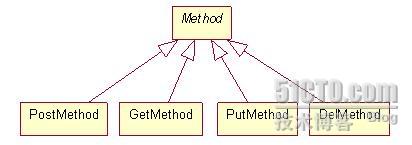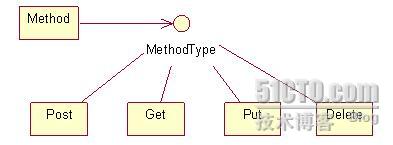在日常開發中,常常會作一些狀態判斷,用到swich-case與if-else。在面向對象的環境裡,有兩種方式可以替代它們。一種是使用繼承子類的多態,另一種是使用state模式。它們使用對象的間接性有效地擺脫了傳統的狀態判斷。
舉個例子。
Method.java
package com.zj.original;
import com.zj.utils.NoMethodTypeException;
public class Method {
private int _type;
public static final int POST = 0;
public static final int GET = 1;
public static final int PUT = 2;
public static final int DELETE = 3;
public Method(int type) {
_type = type;
}
public String getMethod() throws NoMethodTypeException {
switch (_type) {
case POST:
return "This is POST method";
case GET:
return "This is GET method";
case PUT:
return "This is PUT method";
case DELETE:
return "This is DELETE method";
default:
throw new NoMethodTypeException();
}
}
public boolean safeMethod() {
if (_type == GET)
return true;
else
return false;
}
public boolean passwordRequired() {
if (_type == POST)
return false;
else
return true;
}
}
類Method中,存在四個狀態Post、Get、Put和Delete。有一個switch-case判斷,用於輸出四種方法的描述信息;兩個if-else判斷,分別判斷方法是否安全(只有Get方法是安全的),方法是否需要密碼(只有Post方法不需要密碼)。
1.使用繼承子類多態
使用繼承子類多態的方式,通常對於某個具體對象,它的狀態是不可改變的(在對象的生存周期中)。

現在使用四個子類分別代表四種類型的方法。這樣就可以使用多態將各個方法的具體邏輯分置到子類中去了。
在抽象基類Method中可以提供創建子類實例的靜態方法,當然也可以使用Simple Factory模式。對於getMethod()方法,延遲到子類中實現;對於safeMethod()方法和passwordRequired()方法,提供一個默認的實現,這個實現應該符合絕大部分子類的要求,這樣的話,對於少數不符合默認實現的子類只需override相應方法即可。
<<abstract>>Method.java
package com.zj.subclass;
public abstract class Method {
public final static Method createPostMethod() {
return new PostMethod();
}
public final static Method createGetMethod() {
return new GetMethod();
}
public final static Method createPutMethod() {
return new PutMethod();
}
public final static Method createDeleteMethod() {
return new DelMethod();
}
abstract public String getMethod();
public boolean safeMethod() {
return false;
}
public boolean passwordRequired() {
return true;
}
}
四個子類分別繼承和override相應的方法。
PostMethod.java
package com.zj.subclass;
public class PostMethod extends Method {
@Override
public String getMethod() {
return "This is POST method";
}
@Override
public boolean passwordRequired() {
return false;
}
}
GetMethod.java
package com.zj.subclass;
public class GetMethod extends Method{
@Override
public String getMethod() {
return "This is GET method";
}
@Override
public boolean safeMethod() {
return true;
}
}
PutMethod.java
package com.zj.subclass;
public class PutMethod extends Method {
@Override
public String getMethod() {
return "This is PUT method";
}
}
DelMethod.java
package com.zj.subclass;
public class DelMethod extends Method{
@Override
public String getMethod(){
return "This is DELETE method";
}
}
2.使用state模式
如果希望對象在生存周期內,可以變化自己的狀態,則可以選擇state模式。

這裡抽象狀態為一個接口MethodType,四種不同的狀態實現該接口。
<<interface>>MethodType.java
package com.zj.state;
public interface MethodType {
String getTypeDescription();
String getMethodDescription();
boolean isSafe();
boolean isRequired();
}
Post.java
package com.zj.state;
public class Post implements MethodType{
public String getMethodDescription() {
return "This is POST method";
}
public String getTypeDescription() {
return "===POST===";
}
public boolean isRequired() {
return false;
}
public boolean isSafe() {
return false;
}
}
Get.java
package com.zj.state;
public class Get implements MethodType{
public String getMethodDescription() {
return "This is GET method";
}
public String getTypeDescription() {
return "===GET===";
}
public boolean isRequired() {
return true;
}
public boolean isSafe() {
return true;
}
}
Put.java
package com.zj.state;
public class Put implements MethodType{
public String getMethodDescription() {
return "This is PUT method";
}
public String getTypeDescription() {
return "===PUT===";
}
public boolean isRequired() {
return true;
}
public boolean isSafe() {
return false;
}
}
Delete.java
package com.zj.state;
public class Delete implements MethodType{
public String getMethodDescription() {
return "This is DELETE method";
}
public String getTypeDescription() {
return "===DELETE===";
}
public boolean isRequired() {
return true;
}
public boolean isSafe() {
return false;
}
}
此時,在類Method中保存一個field表示MethodType,在某對象中,可以隨時變化四種已知的狀態(具體見runAllMethods()方法)。
Method.java
package com.zj.state;
public class Method {
private MethodType _type;
public Method() {
_type = null;
}
public Method(MethodType type) {
_type = type;
}
public String getMethod() {
return _type.getMethodDescription();
}
public boolean safeMethod() {
return _type.isSafe();
}
public boolean passwordRequired() {
return _type.isRequired();
}
public void changeType(MethodType type) {
_type = type;
}
public void runAllMethods() {
MethodType[] types = new MethodType[] { new Post(), new Get(),
new Put(), new Delete() };
for (MethodType type : types) {
System.out.println(type.getTypeDescription());
changeType(type);
System.out.println(getMethod());
System.out.println(safeMethod());
System.out.println(passwordRequired());
}
}
}
3.測試
在測試類中,分別使用上面3中機制展示結果。它們的結果應該是一致的。
Client.java
package com.zj.utils;
public class Client {
static void print(String s) {
System.out.println(s);
}
static void print(Boolean b) {
System.out.println(b);
}
public static void main(String[] args) throws NoMethodTypeException {
print("===original===");
print("===POST===");
com.zj.original.Method post1 = new com.zj.original.Method(
com.zj.original.Method.POST);
print(post1.getMethod());
print(post1.safeMethod());
print(post1.passwordRequired());
print("===GET===");
com.zj.original.Method get1 = new com.zj.original.Method(
com.zj.original.Method.GET);
print(get1.getMethod());
print(get1.safeMethod());
print(get1.passwordRequired());
print("===PUT===");
com.zj.original.Method put1 = new com.zj.original.Method(
com.zj.original.Method.PUT);
print(put1.getMethod());
print(put1.safeMethod());
print(put1.passwordRequired());
print("===DELETE===");
com.zj.original.Method del1 = new com.zj.original.Method(
com.zj.original.Method.DELETE);
print(del1.getMethod());
print(del1.safeMethod());
print(del1.passwordRequired());
print("===subclass===");
print("===POST===");
com.zj.subclass.Method post2 = com.zj.subclass.Method
.createPostMethod();
print(post2.getMethod());
print(post2.safeMethod());
print(post2.passwordRequired());
print("===GET===");
com.zj.subclass.Method get2 = com.zj.subclass.Method.createGetMethod();
print(get2.getMethod());
print(get2.safeMethod());
print(get2.passwordRequired());
print("===PUT===");
com.zj.subclass.Method put2 = com.zj.subclass.Method.createPutMethod();
print(put2.getMethod());
print(put2.safeMethod());
print(put2.passwordRequired());
print("===DELETE===");
com.zj.subclass.Method del2 = com.zj.subclass.Method
.createDeleteMethod();
print(del2.getMethod());
print(del2.safeMethod());
print(del2.passwordRequired());
print("===state===");
new com.zj.state.Method().runAllMethods();
}
}
本文出自 “子 孑” 博客,請務必保留此出處http://zhangjunhd.blog.51cto.com/113473/68070